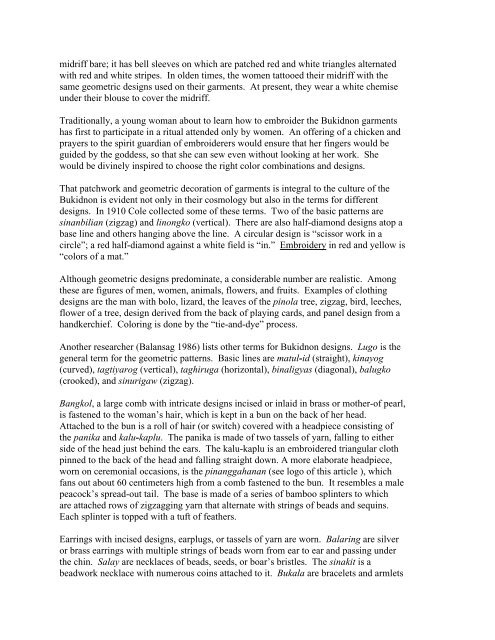You also want an ePaper? Increase the reach of your titles
YUMPU automatically turns print PDFs into web optimized ePapers that Google loves.
midriff bare; it has bell sleeves on which are patched red and white triangles alternated<br />
with red and white stripes. In olden times, the women tattooed their midriff with the<br />
same geometric designs used on their garments. At present, they wear a white chemise<br />
under their blouse to cover the midriff.<br />
Traditionally, a young woman about to learn how to embroider the <strong>Bukidnon</strong> garments<br />
has first to participate in a ritual attended only by women. An offering of a chicken and<br />
prayers to the spirit guardian of embroiderers would ensure that her fingers would be<br />
guided by the goddess, so that she can sew even without looking at her work. She<br />
would be divinely inspired to choose the right color combinations and designs.<br />
That patchwork and geometric decoration of garments is integral to the culture of the<br />
<strong>Bukidnon</strong> is evident not only in their cosmology but also in the terms for different<br />
designs. In 1910 Cole collected some of these terms. Two of the basic patterns are<br />
sinanbilian (zigzag) and linongko (vertical). There are also half-diamond designs atop a<br />
base line and others hanging above the line. A circular design is “scissor work in a<br />
circle”; a red half-diamond against a white field is “in.” Embroidery in red and yellow is<br />
“colors of a mat.”<br />
Although geometric designs predominate, a considerable number are realistic. Among<br />
these are figures of men, women, animals, flowers, and fruits. Examples of clothing<br />
designs are the man with bolo, lizard, the leaves of the pinola tree, zigzag, bird, leeches,<br />
flower of a tree, design derived from the back of playing cards, and panel design from a<br />
handkerchief. Coloring is done by the “tie-and-dye” process.<br />
Another researcher (Balansag 1986) lists other terms for <strong>Bukidnon</strong> designs. Lugo is the<br />
general term for the geometric patterns. Basic lines are matul-id (straight), kinayog<br />
(curved), tagtiyarog (vertical), taghiruga (horizontal), binaligyas (diagonal), balugko<br />
(crooked), and sinurigaw (zigzag).<br />
Bangkol, a large comb with intricate designs incised or inlaid in brass or mother-of pearl,<br />
is fastened to the woman’s hair, which is kept in a bun on the back of her head.<br />
Attached to the bun is a roll of hair (or switch) covered with a headpiece consisting of<br />
the panika and kalu-kaplu. The panika is made of two tassels of yarn, falling to either<br />
side of the head just behind the ears. The kalu-kaplu is an embroidered triangular cloth<br />
pinned to the back of the head and falling straight down. A more elaborate headpiece,<br />
worn on ceremonial occasions, is the pinanggahanan (see logo of this article ), which<br />
fans out about 60 centimeters high from a comb fastened to the bun. It resembles a male<br />
peacock’s spread-out tail. The base is made of a series of bamboo splinters to which<br />
are attached rows of zigzagging yarn that alternate with strings of beads and sequins.<br />
Each splinter is topped with a tuft of feathers.<br />
Earrings with incised designs, earplugs, or tassels of yarn are worn. Balaring are silver<br />
or brass earrings with multiple strings of beads worn from ear to ear and passing under<br />
the chin. Salay are necklaces of beads, seeds, or boar’s bristles. The sinakit is a<br />
beadwork necklace with numerous coins attached to it. Bukala are bracelets and armlets
















